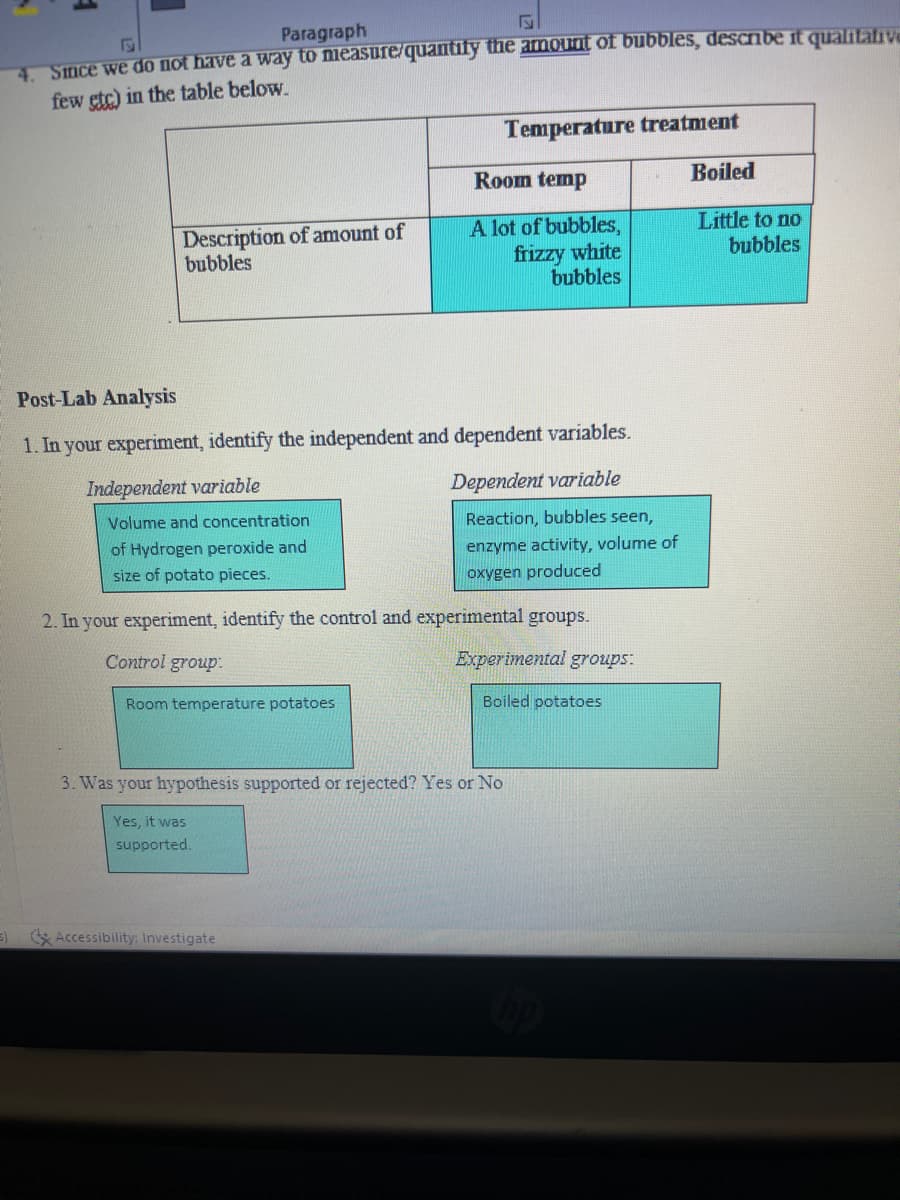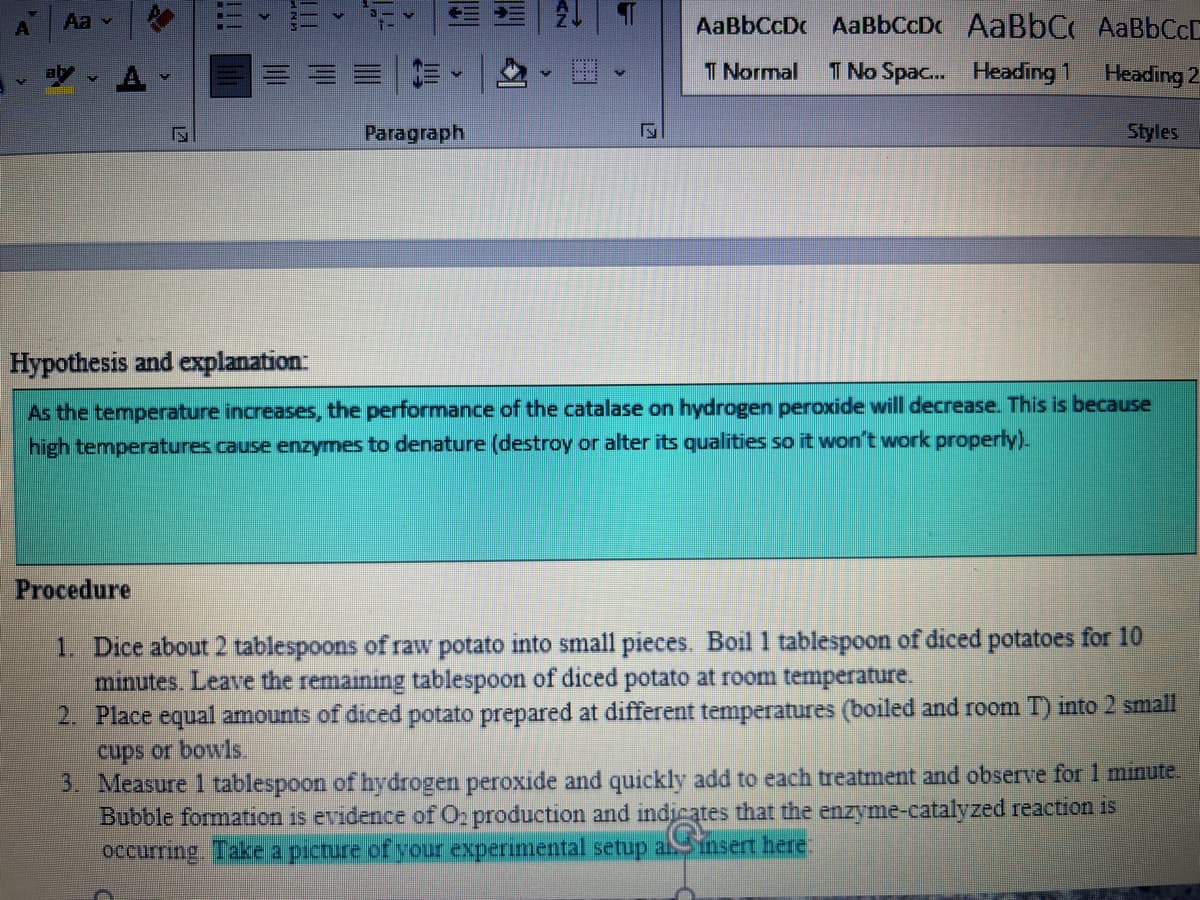Paragraph 4. Since we do not have a way to measure/quantify the amount of bubbles, describe it qualitativ few etc) in the table below. Description of amount of bubbles Post-Lab Analysis 1. In your experiment, identify the independent and dependent variables. Independent variable Dependent variable Reaction, bubbles seen, enzyme activity, volume of oxygen produced Control group: Temperature treatment Room temp A lot of bubbles, frizzy white bubbles Volume and concentration of Hydrogen peroxide and size of potato pieces. 2. In your experiment, identify the control and experimental groups. Room temperature potatoes Experimental groups: Boiled potatoes 3. Was your hypothesis supported or rejected? Yes or No Yes, it was supported. Boiled Little to no bubbles
Paragraph 4. Since we do not have a way to measure/quantify the amount of bubbles, describe it qualitativ few etc) in the table below. Description of amount of bubbles Post-Lab Analysis 1. In your experiment, identify the independent and dependent variables. Independent variable Dependent variable Reaction, bubbles seen, enzyme activity, volume of oxygen produced Control group: Temperature treatment Room temp A lot of bubbles, frizzy white bubbles Volume and concentration of Hydrogen peroxide and size of potato pieces. 2. In your experiment, identify the control and experimental groups. Room temperature potatoes Experimental groups: Boiled potatoes 3. Was your hypothesis supported or rejected? Yes or No Yes, it was supported. Boiled Little to no bubbles
Chapter20: Nucleophilic Substitution Reactions: Competing Nucleophiles
Section: Chapter Questions
Problem 8Q
Related questions
Question
100%
Enzyme hydrogen peroxide potato lab. I am not so sure of my controlled group and experimental group. Some potato pieces were boiled n then hydrogen peroxide was added and the other potatoes were kept at room temperature. I attached the procedure. Please help and thank you in advance ?

Transcribed Image Text:Paragraph
4. Since we do not have a way to measure/quantify the amount of bubbles, describe it qualitative
few etc) in the table below.
Description of amount of
bubbles
Control group.
Post-Lab Analysis
1. In your experiment, identify the independent and dependent variables.
Independent variable
Dependent variable
Volume and concentration
of Hydrogen peroxide and
size of potato pieces.
Reaction, bubbles seen,
enzyme activity, volume of
oxygen produced
2. In your experiment, identify the control and experimental groups.
Room temperature potatoes
Yes, it was
supported.
Temperature treatment
Room temp
A lot of bubbles,
frizzy white
bubbles
3. Was your hypothesis supported or rejected? Yes or No
3) Accessibility: Investigate
Experimental groups:
Boiled potatoes
hp
Boiled
Little to no
bubbles

Transcribed Image Text:Aa ✓
M
IN
Procedure
Paragraph
>
AaBbCcDc AaBbCcD. AaBbC, AaBbCcL
T Normal T No Spac... Heading 1
Heading 2
Styles
Hypothesis and explanation:
As the temperature increases, the performance of the catalase on hydrogen peroxide will decrease. This is because
high temperatures cause enzymes to denature (destroy or alter its qualities so it won't work properly).
1. Dice about 2 tablespoons of raw potato into small pieces. Boil 1 tablespoon of diced potatoes for 10
minutes. Leave the remaining tablespoon of diced potato at room temperature.
2. Place equal amounts of diced potato prepared at different temperatures (boiled and room T) into 2 small
cups or bowls.
3. Measure 1 tablespoon of hydrogen peroxide and quickly add to each treatment and observe for 1 minute.
Bubble formation is evidence of O2 production and indicates that the enzyme-catalyzed reaction is
C
occurring. Take a picture of your experimental setup al insert here:
Expert Solution
This question has been solved!
Explore an expertly crafted, step-by-step solution for a thorough understanding of key concepts.
Step by step
Solved in 2 steps

Knowledge Booster
Learn more about
Need a deep-dive on the concept behind this application? Look no further. Learn more about this topic, chemistry and related others by exploring similar questions and additional content below.Recommended textbooks for you

EBK A SMALL SCALE APPROACH TO ORGANIC L
Chemistry
ISBN:
9781305446021
Author:
Lampman
Publisher:
CENGAGE LEARNING - CONSIGNMENT

EBK A SMALL SCALE APPROACH TO ORGANIC L
Chemistry
ISBN:
9781305446021
Author:
Lampman
Publisher:
CENGAGE LEARNING - CONSIGNMENT